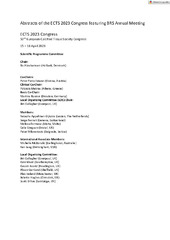| dc.creator | Trivanović, Drenka | |
| dc.creator | Okić Đorđević, Ivana | |
| dc.creator | Živanović, Milena | |
| dc.creator | Vujačić, Marko | |
| dc.creator | Bogosavljević, Nikola | |
| dc.creator | Bugarski, Diana | |
| dc.creator | Jauković, Aleksandra | |
| dc.date.accessioned | 2024-01-23T23:47:16Z | |
| dc.date.available | 2024-01-23T23:47:16Z | |
| dc.date.issued | 2023 | |
| dc.identifier.uri | http://rimi.imi.bg.ac.rs/handle/123456789/1409 | |
| dc.description.abstract | Aging and disease-induced adipogenesis in skeletal system has been described as detrimental process for bone tissue metabolism. Dynamic of adipogenic program is controlled by microenvironmental factors and activity of bone marrow (BM) mesenchymal stromal (stem) cells (MSC)s. As different skeletal locations are not affected by extrinsic factors in same manner, we assumed that marrow adipogenic program can be distinct in acetabular (aMSCs) and femoral MSCs (fMSCs). Here, we compared expanded aMSCs and fMSCs from matched patients undergoing hip arthroplasty (n=6, Ethical approval I-97/11). Cellular and molecular assays were performed to investigate differences in MSC features. Statistical significance was estimated by ANOVA. Results showed that adipogenic stimuli triggered stronger adipogenesis in fMSCs when compared to acetabular counterparts (p=0.036). Tissue non-specific alkaline phosphatase (TNAP) activity and protein expression was higher in fMSCs than in aMSCs, along with significantly higher TNAP levels detected in mitochondrial-enriched fraction proteins in fMSCs. Stronger expression of mitochondrial electron transport chain (ETC) proteins, supercomplexes I and V was found in fMSCs than in aMSCs. This coincided with increased β-galactosidase and total intracellular reactive oxygen species (ROS) production in fMSCs. Lipid droplet accumulation was followed by upregulated tissue beta-galactosidase and TNAP activities, expression of glyceraldehyde 3-phosphate dehydrogenase 24734039, 2023, S3, Downloaded from https://asbmr.onlinelibrary.wiley.com/doi/10.1002/jbm4.10738 by Readcube (Labtiva Inc.), Wiley Online Library on [23/01/2024]. See the Terms and Conditions (https://onlinelibrary.wiley.com/terms-and-conditions) on Wiley Online Library for rules of use; OA articles are governed by the applicable Creative Commons License (GAPDH), in parallel with stimulated ROS and mitochondrial superoxide production in both MSCs. Presence of fatty acid oxidation (FAO) inhibitor etomoxir increased gene expression of fatty acid binding protein (Fabp)4, while decreased protein and gene expression of GAPDH in both populations. Although etomoxir supported adipogenic differentiation and β-galactosidase activity in aMSCs only, TNAP activity and ROS content stayed unaltered.These results indicate that mitochondrial pathways required for energy production, ETC and FAO are bone-specific, and differently affect marrow adipogenesis in acetabular and femoral regions. Further elucidation of marrow adipogenesis can contribute to development of pharmacologic strategies to support skeletal and metabolic health. | sr |
| dc.language.iso | en | sr |
| dc.publisher | American Society for Bone and Mineral Research | sr |
| dc.rights | openAccess | sr |
| dc.source | JBMR PlusVolume 7: Abstracts of the 50th ECTS Congress featuring BRS Annual Meeting, 15-18 April 2023, Liverpool | sr |
| dc.title | Region-specific differences of marrow adipogenesis in mesenchymal stromal (stem) cells of human acetabulum and femur: involvement of fatty acid oxidation | sr |
| dc.type | conferenceObject | sr |
| dc.rights.license | ARR | sr |
| dc.rights.holder | American Society for Bone and Mineral Research | sr |
| dc.citation.issue | 3 | |
| dc.citation.rank | M34 | |
| dc.citation.rank | M34 | |
| dc.citation.spage | P141 | |
| dc.citation.volume | 7 | |
| dc.identifier.fulltext | http://rimi.imi.bg.ac.rs/bitstream/id/3278/bitstream_3278.pdf | |
| dc.identifier.rcub | https://hdl.handle.net/21.15107/rcub_rimi_1409 | |
| dc.type.version | publishedVersion | sr |

